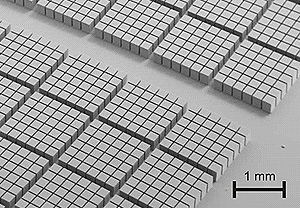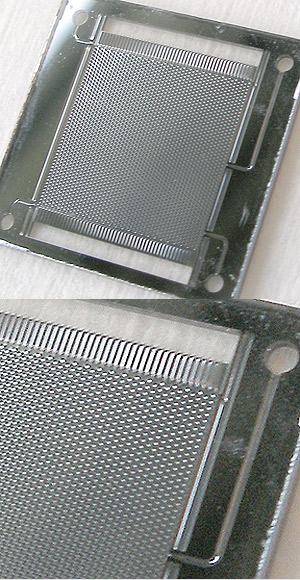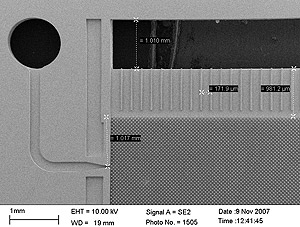
|
|
0%
Abstract: Frostytech departs from the usual pixel fodder for a brief look at some cooling technologies you have never seen before. We touch on some fun tests from the unpublished Frostytech archives and collect all the thermodynamics research we've reported on into one location.
|
Home >
Reviews >
Page: Annex C) Heat Exchangers, Microchannel, Capilliary, Spray Watercooling
|
IBM Develop High Thermal Conductivity Interface
Technology:
The IBM
Zurich Research Laboratory has developed a technique, called "high
thermal conductivity interface technology," which allows a twofold
improvement in heat removal over current methods. This paves the way for
continued development of creative electronic products through the use of
more powerful chips without complex and costly systems simply to cool
them.
The approach used by IBM addresses the connection point between the hot
chip and the various cooling components used today to draw the heat away,
including heat sinks. Special particle-filled viscous pastes are typically
applied to this interface to guarantee that chips can expand and contract
owing to the thermal cycling. This paste is kept as thin as possible in
order to transport heat from chip to the cooling components efficiently.
Using sophisticated micro-technology, the IBM
researchers developed a chip cap with a network of tree-like branched
channels on its surface. The pattern is designed such that when pressure
is applied, the paste spreads much more evenly and the pressure remains
uniform across the chip. This allows the right uniformity to be obtained
with nearly two times less pressure, and a ten times better heat transport
through the interface.

 Looking beyond the limits of air-cooling systems, Zurich researchers
are taking their concept of branched channel design even further and are
developing a novel and promising approach for water-cooling. Called direct
jet impingement, it squirts water onto the back of the chip and pulls it
off again in a perfectly closed system using an array of up to 50,000 tiny
nozzles and a complicated tree-like branched return architecture. By
developing a perfectly closed system, there is also no fear of coolant
getting into the electronics on the chips. The team
has demonstrated cooling power densities of up to 370 Watts per square
centimeter with water as coolant." |
High Heat Flux Nuclear
Waterblocks:
These are three high heat flux (10-20 MW/m2) copper
waterblock test patterns for the International Thermonuclear Experimental
Reactor. Boeing apparently produced these channels with the goal
of incorporating complex coolant channels by close tolerance machining to
create thin webs or slots. These webs and slots are 1-1.5 mm wide and 4-6
mm tall or deep. Although some of the detail parameters are proprietary,
the general design of the coolant channel shows potential for processor
cooling applications. |
|
Thin Film Heat Exchanger :
"The dimensions of MCFs are ideally suited for heat
transfer applications. Due to the small size of the capillaries, the main
resistance to heat transfer is not from the plastic that the film is made
from, but the heat transfer properties of the laminar flow within the
capillaries. This means that, in spite of their plastic construction, the
performance of MCF micro heat exchangers is comparable to those made of
copper where the thermal conductivity of the base material is over 2000
times greater.
The flexible nature of MCFs combined with their excellent heat transfer
properties have led to proof of concept experiments with CPU cooling and
also the evaluation of MCFs in the construction of sports therapy
devices."
CHENG:
"The image above shows the prototype CPU cooler attached to an old AMD
166MHz CPU. With water at room temperature flowing through the film at a
rate of 40ml/min, the chip was held several degrees cooler than with the
conventional heatsink and fan arrangement. With neither the fan nor the
MCF cooler, the CPU would overheat within two minutes."
|
| IBM Cools 3-D Processors with H2O:
"IBM scientists unveiled a powerful and efficient
technique to cool 3-D chip stacks with water. In collaboration with the
Fraunhofer Institute in Berlin, they demonstrated a prototype that
integrates the cooling system into a 3-D chip by piping water directly
between each layer in the stack.
  |
|
|
|
1:
Cryo Tech and New Cooling Technologies You Have Never Seen
2:
Thermoacoustic Cooling
3:
Phase Change Waterchilling
4:
Conduction PCB Cooling via Cold Plate Heat Exchangers
5:
The Stirling Cycle Cryo Cooler
6:
Annex. A) Graphite, Carbon Foam/Fiber, Polymer Heatsinks
7:
Annex A) Graphite, Carbon Foam/Fiber, Polymer Heatsinks
8:
Annex B) Diamond, Nano-structure and Metal Foam Heatsinks
9:
Annex B) Diamond, Nano-structure and Metal Foam Heatsinks
10:
Annex C) Heat Exchangers, Microchannel, Capilliary, Spray Watercooling
11:
Annex C) Heat Exchangers, Microchannel, Capilliary, Spray Watercooling
12: — Annex C) Heat Exchangers, Microchannel, Capilliary, Spray Watercooling
13:
Annex D) Computational Fluid Dynamics and Innovative Heatsink Tech
List all FrostyTech heat sinks that Frostytech tested?
|
|
|
|
 |
Websites you may also like:
PCSTATS
|
|
 |


